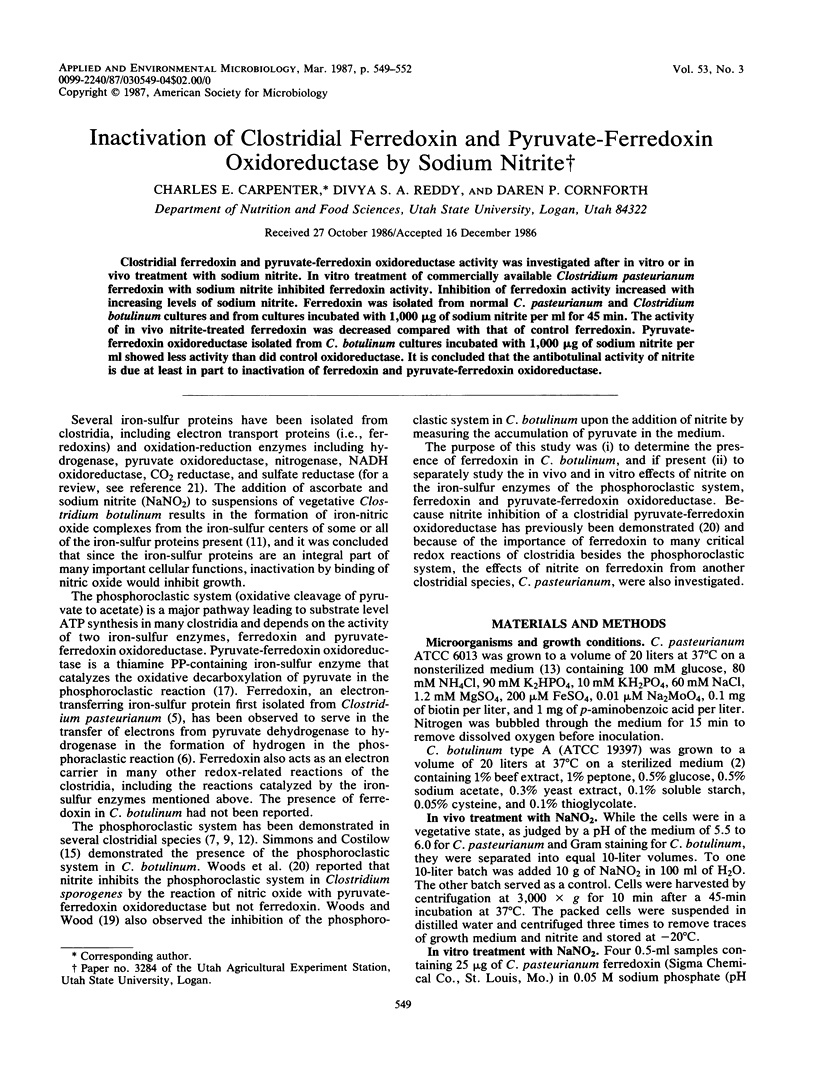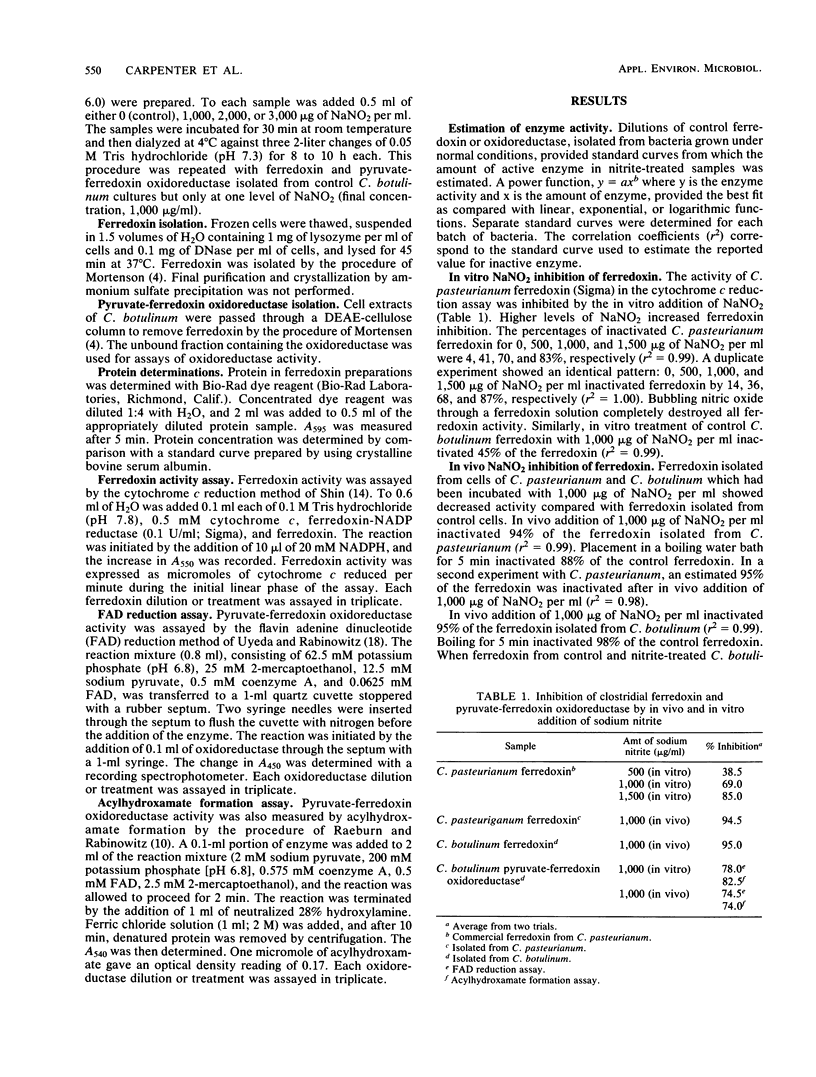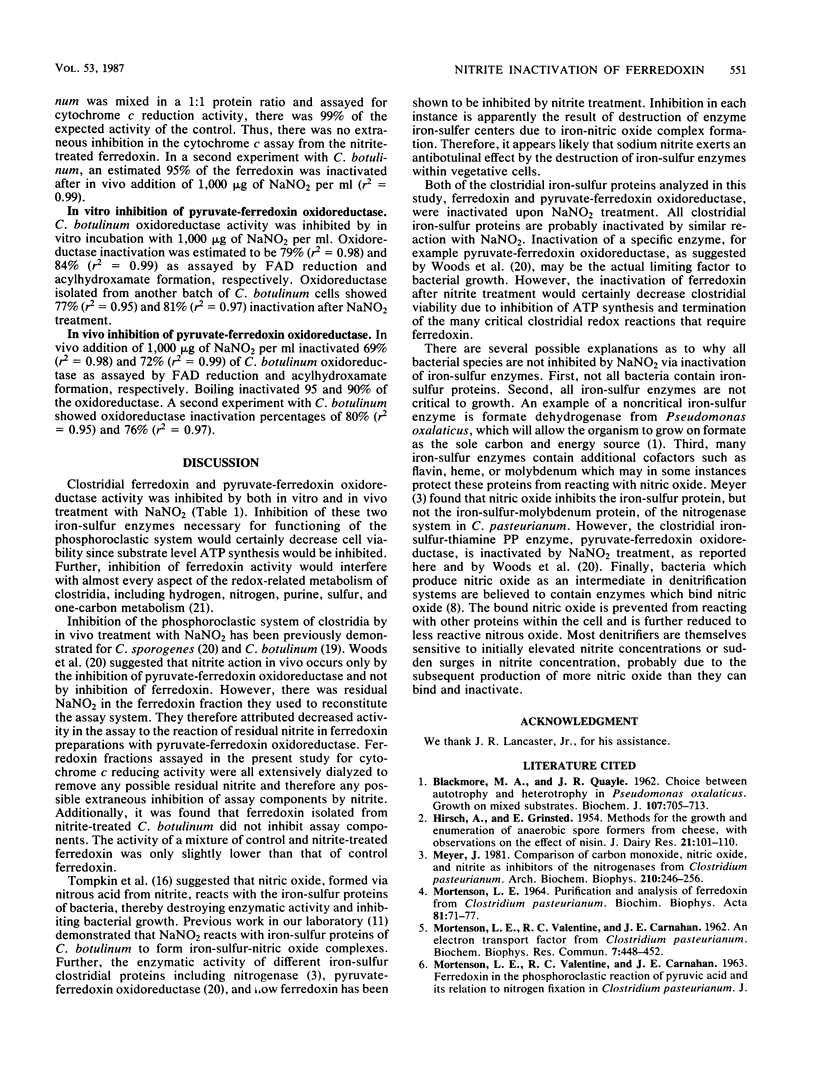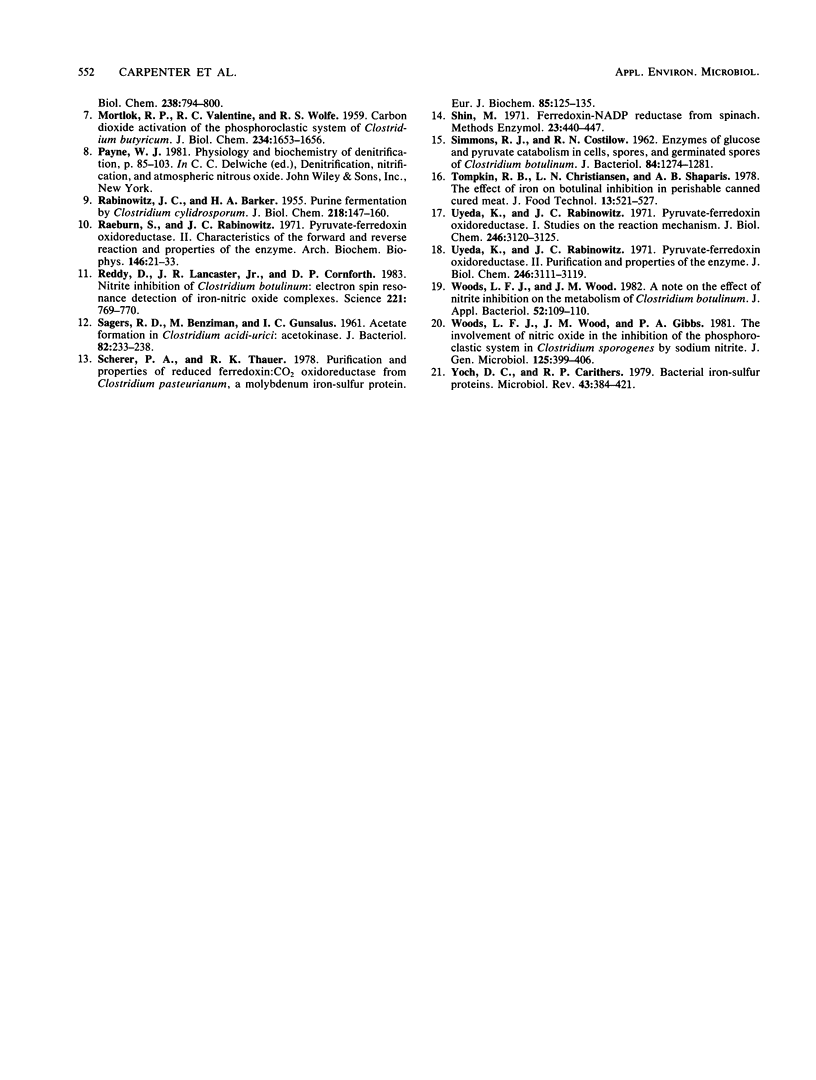Abstract
Clostridial ferredoxin and pyruvate-ferredoxin oxidoreductase activity was investigated after in vitro or in vivo treatment with sodium nitrite. In vitro treatment of commercially available Clostridium pasteurianum ferredoxin with sodium nitrite inhibited ferredoxin activity. Inhibition of ferredoxin activity increased with increasing levels of sodium nitrite. Ferredoxin was isolated from normal C. pasteurianum and Clostridium botulinum cultures and from cultures incubated with 1,000 micrograms of sodium nitrite per ml for 45 min. The activity of in vivo nitrite-treated ferredoxin was decreased compared with that of control ferredoxin. Pyruvate-ferredoxin oxidoreductase isolated from C. botulinum cultures incubated with 1,000 micrograms of sodium nitrite per ml showed less activity than did control oxidoreductase. It is concluded that the antibotulinal activity of nitrite is due at least in part to inactivation of ferredoxin and pyruvate-ferredoxin oxidoreductase.
Full text
PDF



Selected References
These references are in PubMed. This may not be the complete list of references from this article.
- Blackmore M. A., Quayle J. R. Choice between autotrophy and heterotrophy in Pseudomonas oxalaticus. Growth in mixed substrates. Biochem J. 1968 May;107(5):705–713. doi: 10.1042/bj1070705. [DOI] [PMC free article] [PubMed] [Google Scholar]
- MORTENSON L. E., VALENTINE R. C., CARNAHAN J. E. An electron transport factor from Clostridium pasteurianum. Biochem Biophys Res Commun. 1962 Jun 4;7:448–452. doi: 10.1016/0006-291x(62)90333-9. [DOI] [PubMed] [Google Scholar]
- MORTLOCK R. P., VALENTINE R. C., WOLFE R. S. Carbon dioxide activation in the pyruvate clastic system of Clostridium butyricum. J Biol Chem. 1959 Jul;234(7):1653–1656. [PubMed] [Google Scholar]
- Meyer J. Comparison of carbon monoxide, nitric oxide, and nitrite as inhibitors of the nitrogenase from Clostridium pasteurianum. Arch Biochem Biophys. 1981 Aug;210(1):246–256. doi: 10.1016/0003-9861(81)90186-7. [DOI] [PubMed] [Google Scholar]
- RABINOWITZ J. C., BARKER H. A. Purine fermentation by Clostridium cylindrosporum. I. Tracer experiments on the fermentation of guanine. J Biol Chem. 1956 Jan;218(1):147–160. [PubMed] [Google Scholar]
- Raeburn S., Rabinowitz J. C. Pyruvate: ferredoxin oxidoreductase. II. Characteristics of the forward and reverse reactions and properties of the enzyme. Arch Biochem Biophys. 1971 Sep;146(1):21–33. doi: 10.1016/s0003-9861(71)80037-1. [DOI] [PubMed] [Google Scholar]
- Reddy D., Lancaster J. R., Jr, Cornforth D. P. Nitrite inhibition of Clostridium botulinum: electron spin resonance detection of iron-nitric oxide complexes. Science. 1983 Aug 19;221(4612):769–770. doi: 10.1126/science.6308761. [DOI] [PubMed] [Google Scholar]
- SAGERS R. D., BENZIMAN M., GUNSALUS I. C. Acetate formation in Clostridium acidi-urici: acetokinase. J Bacteriol. 1961 Aug;82:233–238. doi: 10.1002/path.1700820136. [DOI] [PMC free article] [PubMed] [Google Scholar]
- SIMMONS R. J., COSTILOW R. N. Enzymes of glucose and pyruvate catabolism in cells, spores, and germinated spores of Clostridium botulinum. J Bacteriol. 1962 Dec;84:1274–1281. doi: 10.1128/jb.84.6.1274-1281.1962. [DOI] [PMC free article] [PubMed] [Google Scholar]
- Scherer P. A., Thauer R. K. Purification and properties of reduced ferredoxin: CO2 oxidoreductase from Clostridium pasteurianum, a molybdenum iron-sulfur-protein. Eur J Biochem. 1978 Apr;85(1):125–135. doi: 10.1111/j.1432-1033.1978.tb12220.x. [DOI] [PubMed] [Google Scholar]
- Uyeda K., Rabinowitz J. C. Pyruvate-ferredoxin oxidoreductase. 3. Purification and properties of the enzyme. J Biol Chem. 1971 May 25;246(10):3111–3119. [PubMed] [Google Scholar]
- Uyeda K., Rabinowitz J. C. Pyruvate-ferredoxin oxidoreductase. IV. Studies on the reaction mechanism. J Biol Chem. 1971 May 25;246(10):3120–3125. [PubMed] [Google Scholar]
- Woods L. F., Wood J. M. A note on the effect of nitrite inhibition on the metabolism of Clostridium botulinum. J Appl Bacteriol. 1982 Feb;52(1):109–110. doi: 10.1111/j.1365-2672.1982.tb04380.x. [DOI] [PubMed] [Google Scholar]
- Woods L. F., Wood J. M., Gibbs P. A. the involvement of Nitric Oxide in the inhibition of the phosphoroclastic system in Clostridium sporogenes by sodium nitrite. J Gen Microbiol. 1981 Aug;125(2):399–406. doi: 10.1099/00221287-125-2-399. [DOI] [PubMed] [Google Scholar]
- Yoch D. C., Carithers R. P. Bacterial iron-sulfur proteins. Microbiol Rev. 1979 Sep;43(3):384–421. doi: 10.1128/mr.43.3.384-421.1979. [DOI] [PMC free article] [PubMed] [Google Scholar]


